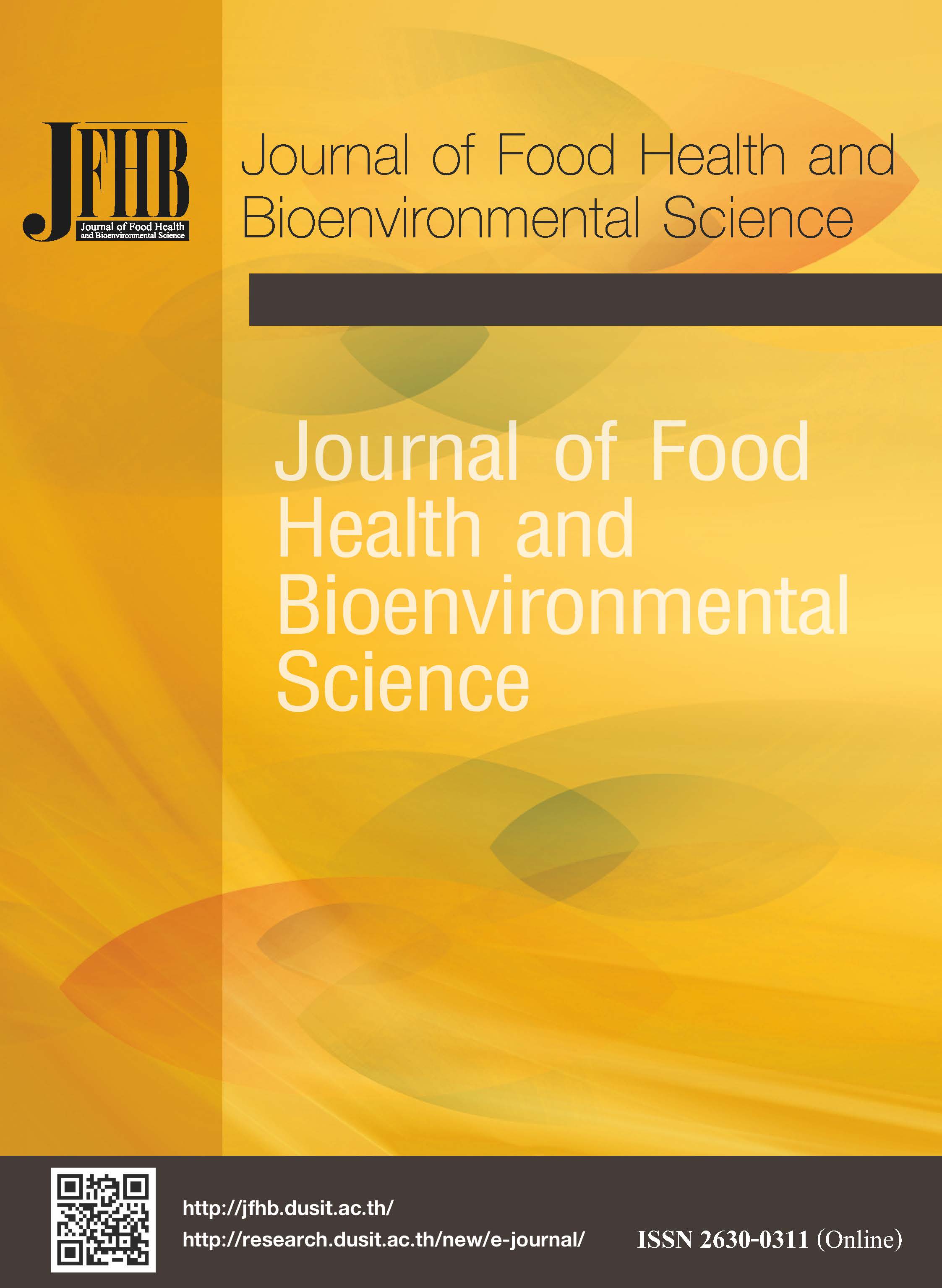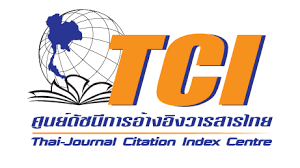The Qualities of Reconstructed Liquid Egg White Utilizing Plant-based Proteins
Keywords:
Meat substitute, Plant protein, High protein dietAbstract
This study aimed to evaluate the properties of reconstructed liquid egg white formulated with plant proteins isolated from various sources (soy, pea, rice, and mung bean) and supplemented with carrageenan at concentrations ranging from 0% to 5%. The reconstructed products were prepared by mixing all ingredients, molding, and steaming to achieve the desired structure. Key quality attributes, including appearance, pH, color, water activity (aw), texture, suitability for dysphagia diets, and sensory characteristics, were analyzed. The reconstructed liquid egg white with plant proteins exhibited an acceptable appearance and texture, resembling meat analogues. The addition of carrageenan significantly influenced the textural properties, with 3% carrageenan yielding the highest values for hardness, springiness, gumminess, and chewiness—characteristics desirable for the final product. The fork pressure test confirmed that the products met the criteria for dysphagia diets. However, sensory evaluation revealed relatively low acceptance scores across most attributes, with maximum scores below 7 ("like moderately"). Despite this, the products contained a high protein content, ranging from 19% to 22% on a wet basis. This study demonstrates a straightforward approach to formulating texturized foods using egg white and plant proteins, both high-quality protein sources, offering potential applications in specialized diets and protein-enriched food products.
References
Abeyrathne, E.D.N.S., Lee, H.Y., & Ahn, D.U. (2013). Egg white proteins and their potential use in food processing or as nutraceutical and pharmaceutical agents—A review. Poultry Science, 92(12), 3292–3299.
Antonio, J. (2019). High-protein diets in trained individuals. Research in Sports Medicine, 27(2), 195–203.
Boukid, F. (2021). Plant-based meat analogues: from niche to mainstream. European Food Research and Technology, 247(2), 297–308.
Chadwick, D.D. (2014). Balancing safety and enjoyment. Current practice when recommending tastes for people with intellectual disabilities who are non-orally fed. Appetite, 81, 152–161.
Chiang, J.H., Tay, W., Ong, D.S.M., Liebl, D., Ng, C.P., & Henry, C.J. (2021). Physicochemical, textural and structural characteristics of wheat gluten-soy protein composited meat analogues prepared with the mechanical elongation method. Food Structure, 28, 100183.
Cichero, J.A.Y., Lam, P., Steele, C.M., Hanson, B., Chen, J., Dantas, R.O., ... Murray, J. (2017). Development of international terminology and definitions for texture-modified foods and thickened fluids used in dysphagia management: the IDDSI framework. Dysphagia, 32(2), 293–314.
Dekkers, B.L., Boom, R.M., & van der Goot, A.J. (2018). Structuring processes for meat analogues. Trends in Food Science & Technology, 81, 25-36.
Dinani, S.T., Broekema, N.L., Boom, R., & van der Goot, A.J. (2023). Investigation potential of hydrocolloids in meat analogue preparation. Food Hydrocolloids, 135, 108199.
Gang-Jee, K., Connie, R.M., Kamyar, K.-Z., & Shivam, J. (2020). The effects of high-protein diets on kidney health and longevity. Journal of the American Society of Nephrology, 31(8), 1667–1679.
Godschalk-Broers, L., Sala, G., & Scholten, E. (2022). Meat analogues: Relating structure to texture and sensory perception. Foods, 11(15), 2227.
Gomes, A., & Sobral, P.J.A. (2021). Plant protein-based delivery systems: An emerging approach for increasing the efficacy of lipophilic bioactive compounds. Molecules, 27(1), 60.
Gorissen, S.H.M., Crombag, J.J.R., Senden, J.M.G., Waterval, W.A.H., Bierau, J., Verdijk, L.B., ...van Loon, L.J.C. (2018). Protein content and amino acid composition of commercially available plant-based protein isolates. Amino Acids, 50(12), 1685–1695.
Guyomarc’h, F., Arvisenet, G., Bouhallab, S., Canon, F., Deutsch, S.-M., Drigon, V., ... Guédon, E. (2021). Mixing milk, egg and plant resources to obtain safe and tasty foods with environmental and health benefits. Trends in Food Science & Technology, 108, 119–132.
Ilhamto, N., Keller, H.H., & Duizer, L.M. (2014). The effect of varying ingredient composition on the sensory and nutritional properties of a pureed meat and vegetable. Journal of Nutrition in Gerontology and Geriatrics, 33(3), 229–248.
Kuang, J., Hamon, P., Lechevalier, V., & Saurel, R. (2023). Thermal behavior of pea and egg white protein mixtures. Foods, 12(13), 2528.
Kusmy, P., Saxena Pal, R., Chaitanya, M.V.N.L., & Pal, Y. (2024). A comprehensive investigation into the relationship between dietary therapy strategies for metabolic illnesses and the underlying myriad factors. Current Nutrition & Food Science, 20(5), 586–601.
Lee, H.R., Cho, I., Yi, H., & Park, H.J. (2024). High-protein products in 2013 and 2023: Shifts in diverse aspects over the last ten years. Food Supplements and Biomaterials for Health, 4(2), e9.
Liu, Y., An, D., Xiao, Q., Chen, F., Zhang, Y., Weng, H., ... Xiao, A. (2022). A novel κ-carrageenan extracting process with calcium hydroxide and carbon dioxide. Food Hydrocolloids, 127, 107507.
Loret, C. (2015). Using sensory properties of food to trigger swallowing: a review. Critical Reviews in Food Science and Nutrition, 55(1), 140–145.
Lv, X., Huang, X., Ma, B., Chen, Y., Batool, Z., Fu, X., ... Jin, Y. (2022). Modification methods and applications of egg protein gel properties: A review. Comprehensive Reviews in Food Science and Food Safety, 21(3), 2233–2252.
Matsuoka, R., & Sugano, M. (2022). Health functions of egg protein. Foods, 11(15), 2309.
Mishal, S., Kanchan, S., Bhushette, P., & Sonawane, S.K. (2022). Development of plant-based meat analogue. Food Science and Applied Biotechnology, 5(1), 45–53.
Nikbakht Nasrabadi, M., Sedaghat Doost, A., & Mezzenga, R. (2021). Modification approaches of plant-based proteins to improve their techno-functionality and use in food products. Food Hydrocolloids, 118, 106789.
Raheem, D., Carrascosa, C., Ramos, F., Saraiva, A., & Raposo, A. (2021). Texture-modified food for dysphagic patients: a comprehensive review. International Journal of Environmental Research and Public Health, 18(10), 5125.
Samard, S., & Ryu, G. (2019). A comparison of physicochemical characteristics, texture, and structure of meat analogue and meats. Journal of the Science of Food and Agriculture, 99(6), 2708–2715.
SBCS. (2023). Marketing of high protein food supplements in Thailand and the trend. Available URL: https://www.sbcs.co.th/th/articles/?p=161 (Accessed 16 January 2025).
Sha, L., & Xiong, Y.L. (2020). Plant protein-based alternatives of reconstructed meat: Science, technology, and challenges. Trends in Food Science & Technology, 102, 51-61.
Singh, M., Trivedi, N., Enamala, M.K., Kuppam, C., Parikh, P., Nikolova, M.P., … Chavali, M. (2021). Plant-based meat analogue (PBMA) as a sustainable food: a concise review. European Food Research and Technology, 247(10), 2499–2526.
Sun, C., Fu, J., Chang, Y., Li, S., & Fang, Y. (2022). Structure design for improving the characteristic attributes of extruded plant-based meat analogues. Food Biophysics, 17(2), 137–149.
Sungsinchai, S., Niamnuy, C., Wattanapan, P., Charoenchaitrakool, M., & Devahastin, S. (2019). Texture modification technologies and their opportunities for the production of dysphagia foods: A review. Comprehensive Reviews in Food Science and Food Safety, 18(6), 1898–1912.
Tatiyatrirong, T. (2024). The impact of including whole eggs as a supplementary source of protein on the academic performance of Thai children in primary schools. Journal of Food Health and Bioenvironmental Science, 17(1), 52–65.
Tomczyńska-Mleko, M., Terpiłowski, K., Pérez-Huertas, S., Sapiga, V., Polischuk, G., Sołowiej, B., … Mleko, S. (2023). Co-gelation of pumpkin-seed protein with egg-white protein. Foods, 12(10), 2030.
WHO. (2007). Protein and amino acid requirements in human nutrition: report of a joint FAO/WHO/UNU expert consultation. Geneva: Switzerland.
Yuan, X., Jiang, W., Zhang, D., Liu, H., & Sun, B. (2021). Textural, sensory and volatile compounds analyses in formulations of sausages analogue elaborated with edible mushrooms and soy protein isolate as meat substitute. Foods, 11(1), 52.
Yuliarti, O., Kiat Kovis, T.J., & Yi, N.J. (2021). Structuring the meat analogue by using plant-based derived composites. Journal of Food Engineering, 288, 110138.
Downloads
Published
How to Cite
Issue
Section
License
Copyright (c) 2025 Journal of Food Health and Bioenvironmental Science

This work is licensed under a Creative Commons Attribution-NonCommercial-NoDerivatives 4.0 International License.








